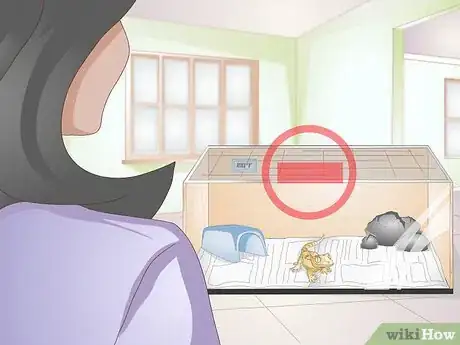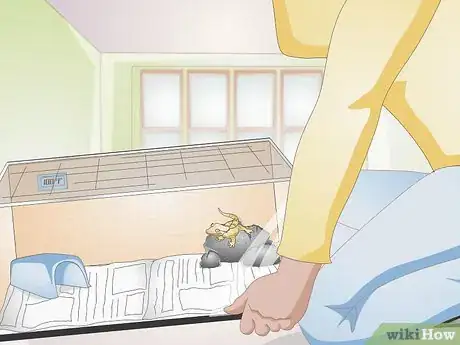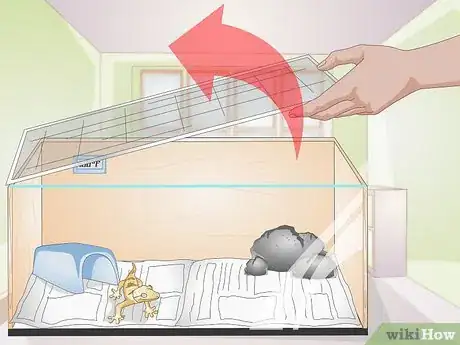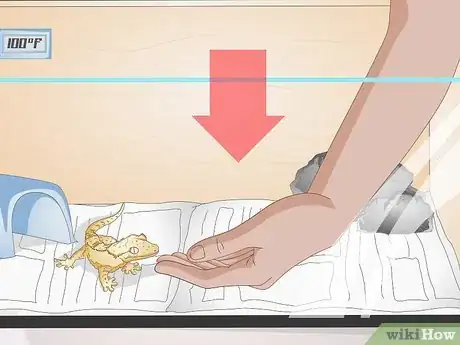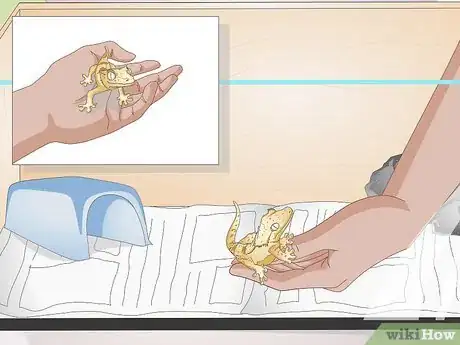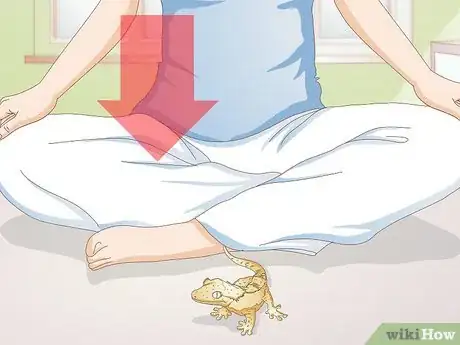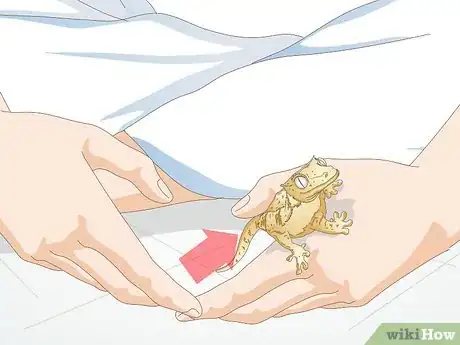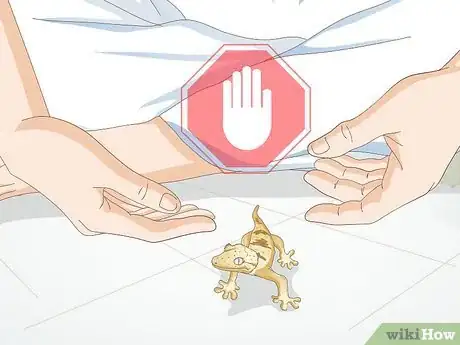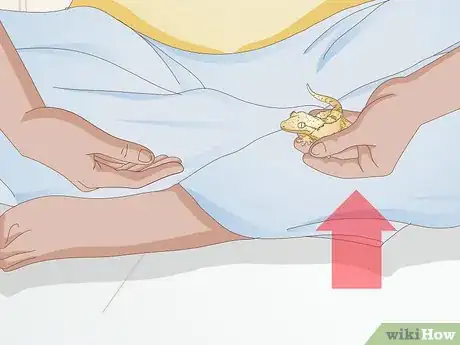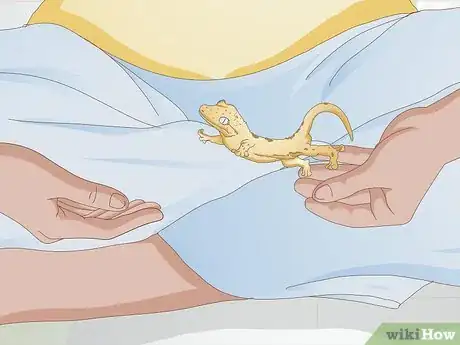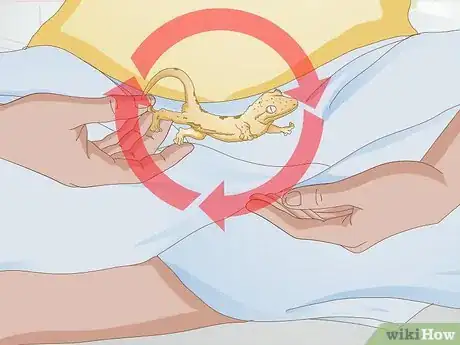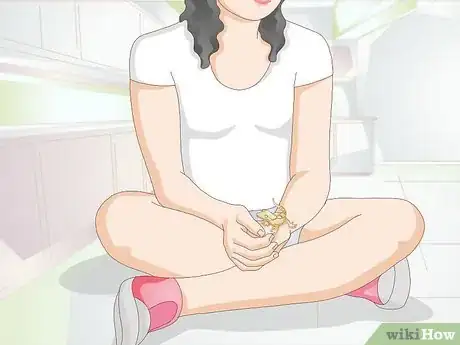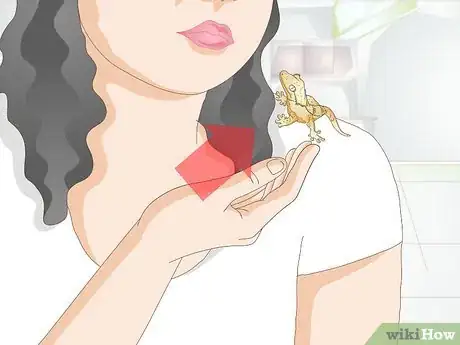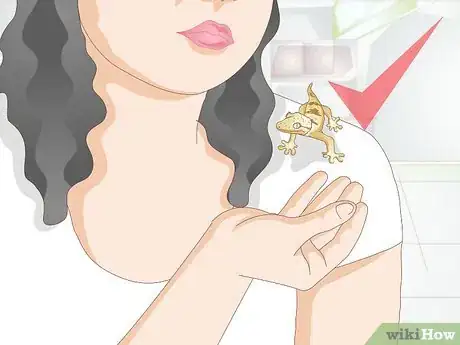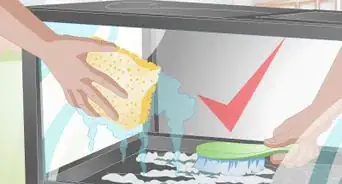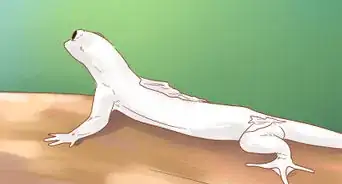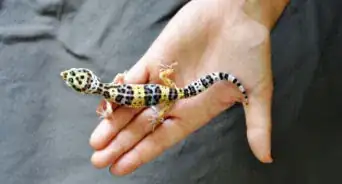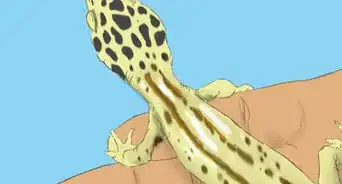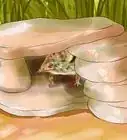This article was co-authored by Audra Barrios. Audra Barrios is a Marine Biologist and owner of Lick Your Eyeballs, a business offering experiemces, reptiles, supplies and plants. With over 15 years of experience, Audra specializes in reptiles and exotic animals, environmental education, marine biology, conservation issues, and animal husbandry. Audra earned a BASc in Marine Biology from the University of California, Santa Cruz, and studied Natural Sciences at the College of Marin. She is the founder and Executive Director of Things That Creep, a non-profit dedicated to herptile conservation through education. She has spent the last nine years working as a biologist at the California Academy of Sciences.
There are 10 references cited in this article, which can be found at the bottom of the page.
wikiHow marks an article as reader-approved once it receives enough positive feedback. In this case, 100% of readers who voted found the article helpful, earning it our reader-approved status.
This article has been viewed 44,219 times.
Crested geckos are considered one of the easiest lizards to handle, but even they can become upset or stressed out by improper handling.[1] Handling a crested gecko isn't hard, but it takes a little care and a gentle touch. Take care of your crested gecko, and handling him will be an enjoyable activity for both of you.
Steps
Removing the Gecko from the Cage
-
1Let your gecko adjust to his new home. When geckos are brought into a new cage or house, they are very defensive and scared. Geckos need time to get used to their new home before you can handle them. Allow him three to four weeks to settle in before you pick him up.[2]
- Babies should not be handled before they have grown to three inches long.
-
2Bring the gecko's cage into an enclosed room. All windows and doors should be closed. The floor should be cleared of toys, books, and other objects. Turn off any TV, music, or radio. This will create a calm environment while preventing your gecko from escaping.Advertisement
-
3Open the cage slowly. Very gently remove the top of the cage, and set it aside. Do not toss or drop the top; the noise may frighten your gecko. Geckos can be easily stressed out by movement and noise. They will become flighty, running around the cage. They may even bite you or drop their tail.[3]
-
4Lower your hand in front of your gecko. With your hand flat, slowly place it in the cage in front of your gecko. The gecko may run away at first. Simply move your hand towards the gecko. Avoid making quick or abrupt movements. Your gecko will realize after a minute or two that you are not going to hurt him.
- You do not want to reach in and grab your gecko. Sudden snatching may cause your gecko to drop his tail.[4] Tails do not grow back on crested geckos, so it is good to avoid this.
- If your gecko refuses to climb on your hand, replace the top of the cage, and try again later. Your gecko does not want to be handled.
-
5Pick up your gecko. Slide your hand under his chin, and let him crawl onto you. Lift the gecko out on the flat of your hand. He should be resting comfortably on your finger, palm, or arm. [5] Cup your other hand under him in case he falls off or jumps. If he tries to run to the other side of your hand, turn your hand so that he remains on top at all times.
- If he does not crawl onto you, you can try sliding your hand under more of his body while slipping your other hand under his tail. Wait for him to grip onto you before you lift him out of the cage.
- Do not hold the gecko by his tail, and do not grasp him with two fingers. A flat or slightly cupped palm is key. He may also rest against your arm.[6]
-
6Return the gecko when you are done. Cup your gecko in the palm of your hand, and lower him into the cage. Put your hand as low as possible so that he does not have to jump off. He may climb off your hand immediately. If not, you may nudge him off with your finger.
Hand-Walking Your Gecko
-
1Sit with your gecko close to the ground.[7] You can also sit at a table or couch, so long as there is a surface close beneath you. Your gecko may tumble while you handle him, and sitting will minimize the distance that he falls. Crested geckos can jump large distances, so don’t be alarmed if he takes off.[8]
- If your gecko manages to escape, you should approach him slowly. Pick him up by sliding your hands under him. Try to avoid grabbing or squeezing him if possible. It helps if you are in an enclosed room with few small spaces for him to hide.
-
2Move your hands as your gecko climbs. Both hands should be touching so that your lizard can easily climb from one hand to another. As soon as the gecko leaves the one hand, move that hand in front of the other. Your gecko will climb onto that one since it is highest. This will create a treadmill effect that allows your gecko to keep climbing.[9]
-
3Repeat until your gecko stops. Once your gecko stops climbing, it is time to put him away. Over-handling your gecko can induce stress, which may cause him to stop eating. Fifteen to twenty minutes is about as long as one gecko can handle at a time.[10] Handling him a few times a week will build the amount of time that your gecko will spend out of his cage with you.
- If you are handling a new or baby gecko, start with short five minute sessions. After a couple sessions, increase this to ten minutes and fifteen until he is comfortable with your handling.[11]
- New and baby lizards will need several sessions of hand walking until they are comfortable enough to sit and hang out with you.[12]
Letting Your Gecko Jump
-
1Hold your gecko close to the ground with one hand. Position your free hand a short distance away from the other hand. Since he will be jumping, you want to prevent any potential injuries. If your gecko does fall, check him over for injuries such as bruising or broken limbs. If your gecko is not walking normally after a fall, take him to see a vet.
- Do not be alarmed if his tail falls off. This is normal in crested geckos. Tail loss is a natural response to stress or fear. In the wild, they lose their tails to get away from predators. Your gecko will be fine after dropping his tail, although it will not grow back. There may be a stump left afterwards.
-
2Wait for him to jump. Make sure your free hand is slightly higher with a short distance between them. You will know if your gecko will jump because of his body language. His toes will move in front of his head as his body pushes back and up. His eyes will also be locked on the other hand as he aims for it. [13]
-
3Practice. Your gecko may not be comfortable with jumping between hands at first. As you handle him, you can give him room to jump, and over time, he will become more comfortable with your handling. He may also jump straight over your hand. Catch him if he does, and place him back on your arm.
Training Your Gecko to Sit on Your Shoulder
-
1Sit on the ground with your gecko. You should remain absolutely still while your gecko is on your shoulder, so take a seat, preferably on the ground. Give him five minutes to relax in your hands. Sudden movements will startle your gecko, causing him to either fall off or flee up onto your head.
- Do not walk around while your gecko is on your shoulder.
-
2Lift your hand gently up to your shoulder. Hold your hand with the gecko against your shoulder for a minute. As you do so, do not make eye contact with your gecko. This may frighten him.[14] He may at this point wander by himself onto your shoulder. He may, however, remain still in your hand for a minute.
-
3Slide him onto your shoulder. If he does not move on his own, you can gently place him on your shoulder. You can slightly tip your hand so that he steps down onto your shoulder. Alternatively, you can place your cupped hand just below the shoulder and nudge him off so that he climbs the shoulder naturally.
- Your gecko may try to climb your face and head. This does not particularly hurt, although he can scratch you, and it is much more difficult to catch him once he is on your head. If he attempts to flee up your neck, catch him and replace him on your shoulder.[15]
-
4Cup your hand by your shoulder to catch him again. With slow movements, slide your hand under his chin. Once he climbs on your hand, lift him away, and return him to his cage. Hanging out on your shoulder may have stressed or exhausted your lizard, so give him plenty of time to recuperate.
- Start with short sessions at first, no more than five or ten minutes long. If your gecko keeps trying to flee your shoulder, place him back in your hands. Try again another day.
Expert Q&A
-
QuestionDo crested geckos like to be handled?
 Audra BarriosAudra Barrios is a Marine Biologist and owner of Lick Your Eyeballs, a business offering experiemces, reptiles, supplies and plants. With over 15 years of experience, Audra specializes in reptiles and exotic animals, environmental education, marine biology, conservation issues, and animal husbandry. Audra earned a BASc in Marine Biology from the University of California, Santa Cruz, and studied Natural Sciences at the College of Marin. She is the founder and Executive Director of Things That Creep, a non-profit dedicated to herptile conservation through education. She has spent the last nine years working as a biologist at the California Academy of Sciences.
Audra BarriosAudra Barrios is a Marine Biologist and owner of Lick Your Eyeballs, a business offering experiemces, reptiles, supplies and plants. With over 15 years of experience, Audra specializes in reptiles and exotic animals, environmental education, marine biology, conservation issues, and animal husbandry. Audra earned a BASc in Marine Biology from the University of California, Santa Cruz, and studied Natural Sciences at the College of Marin. She is the founder and Executive Director of Things That Creep, a non-profit dedicated to herptile conservation through education. She has spent the last nine years working as a biologist at the California Academy of Sciences.
Reptile Specialist If you handle your crested gecko very gently with open hands, they may enjoy it. The key is to avoid any loud noises or sudden movements that may stress them out. It's also important to handle your gecko close to ground so they don't accidentally fall while jumping.
If you handle your crested gecko very gently with open hands, they may enjoy it. The key is to avoid any loud noises or sudden movements that may stress them out. It's also important to handle your gecko close to ground so they don't accidentally fall while jumping. -
QuestionWhat do I do if the gecko does respond to all four of these methods?
 Community AnswerIt could be that it just needs a little more time to adjust. Try just talking to it for a while. You need to build up a trust with it, make sure it knows you don't mean to harm it. Put your hands close to it, but don't grab it until it's comfortable.
Community AnswerIt could be that it just needs a little more time to adjust. Try just talking to it for a while. You need to build up a trust with it, make sure it knows you don't mean to harm it. Put your hands close to it, but don't grab it until it's comfortable. -
QuestionCan I put my hand over the gecko?
 Community AnswerIf you place your hand over the gecko, your gecko might become scared, thinking that a predator has swooped down upon them. It is generally advised that you only lift your gecko from beneath. Grabbing him from below or covering him with a hand will scare him, and it may cause him to drop his tail.
Community AnswerIf you place your hand over the gecko, your gecko might become scared, thinking that a predator has swooped down upon them. It is generally advised that you only lift your gecko from beneath. Grabbing him from below or covering him with a hand will scare him, and it may cause him to drop his tail.
Warnings
- It is rare, but crested geckos may bite under extreme duress. They are not strong biters, and you most likely will not receive more than a nip. Regardless, that is your gecko telling you that it does not wish to be handled. Put them away for the day.⧼thumbs_response⧽
- If you are high above the ground and your gecko falls, check to see if he's hurt and go to a herp vet as soon as possible to make sure your gecko is okay.⧼thumbs_response⧽
References
- ↑ Audra Barrios. Marine Biologist & Reptile Specialist. Expert Interview. 18 August 2020.
- ↑ http://www.reptilesmagazine.com/Care-Sheets/Lizards/Crested-Gecko/
- ↑ http://www.anapsid.org/handlingreptiles.html
- ↑ Audra Barrios. Marine Biologist & Reptile Specialist. Expert Interview. 18 August 2020.
- ↑ http://animals.mom.me/teach-crested-gecko-stay-shoulder-10858.html
- ↑ http://www.anapsid.org/handlingreptiles.html
- ↑ Audra Barrios. Marine Biologist & Reptile Specialist. Expert Interview. 18 August 2020.
- ↑ Audra Barrios. Marine Biologist & Reptile Specialist. Expert Interview. 18 August 2020.
- ↑ https://www.youtube.com/watch?v=6OcoP1Rc8po&feature=youtu.be&t=69
- ↑ http://www.gargoylequeen.com/caresheet.html
- ↑ http://www.reptilesmagazine.com/Care-Sheets/Lizards/Crested-Gecko/
- ↑ http://www.pangeareptile.com/store/crested-gecko-care-sheet-en.html
- ↑ http://www.neherpetoculture.com/gargscrestiescaresheet
- ↑ http://animals.mom.me/teach-crested-gecko-stay-shoulder-10858.html
- ↑ http://animals.mom.me/teach-crested-gecko-stay-shoulder-10858.html
- ↑ http://www.crestedgecko.com/crested-gargoyle
- ↑ http://www.pangeareptile.com/store/crested-gecko-care-sheet-en.html
- ↑ http://www.reptilesmagazine.com/Care-Sheets/Lizards/Crested-Gecko/
- ↑ Audra Barrios. Marine Biologist & Reptile Specialist. Expert Interview. 18 August 2020.
About This Article
Before handling a crested gecko, make sure its cage is in a secure room so it doesn't escape when you take it out. Then, slowly place your hand in front of your gecko with your palm facing up, and wait for it to climb onto you. Avoid grabbing your gecko if it doesn't want to be picked up since a crested gecko can drop its tail when it's scared, and it won't grow back. Once your gecko is on your hand, carefully lift it out of the cage. For more advice from our Veterinary co-author, like how to play with your crested gecko, scroll down!

